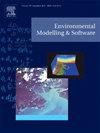让生态系统为自己说话:一种绘制景观声学异质性的无监督方法
IF 4.8
2区 环境科学与生态学
Q1 COMPUTER SCIENCE, INTERDISCIPLINARY APPLICATIONS
引用次数: 0
摘要
被动声波监测(Passive Sonic Monitoring, PSM)是指对声音形成的图案和结构进行分析,为传统的景观分析方法(如卫星图像)提供了一种补充方法。特别是,基于卫星的方法单独可能会忽略生物体在多个分类水平上的特定动态和局部非生物相互作用。本文介绍了一种新的无监督方法来绘制声景之间的相似度。使用高斯混合模型(GMM),这种方法生成了揭示全天生态过程的声景图。我们将我们的方法应用于哥伦比亚奥里诺quia异质生态系统内94个站点的数据。我们发现了聚类图、卫星图像和生物存在(鸟类和两栖动物的声型)之间的相关性。我们的研究结果与已建立的遥感数据一致,揭示了以前未被识别的声音模式,提供了新的生态见解,补充了传统的景观评估。我们的方法弥合了图像卫星评估和生态声波过程之间的差距,为全面的长期生物多样性监测铺平了道路。本文章由计算机程序翻译,如有差异,请以英文原文为准。

Letting ecosystems speak for themselves: An unsupervised methodology for mapping landscape acoustic heterogeneity
Passive Sonic Monitoring (PSM) refers to the analysis of patterns and structures shaped by sound, offering a complementary approach to traditional landscape analysis methods, such as satellite imagery. In particular, satellite-based methods alone may overlook specific dynamics of the organism at multiple taxonomic levels and local abiotic interactions. This paper introduces a novel unsupervised methodology for mapping similarities between soundscapes. Using Gaussian Mixture Models (GMM), this approach generates soundscape maps that reveal ecological processes throughout the day. We applied our methodology to data from 94 sites within a heterogeneous Colombian Orinoquia ecosystem. We found correlations between the cluster maps, satellite images, and biotic presences (bird and amphibian sonotypes). Our results align with established remote-sensing data and uncover previously unrecognized sonic patterns, offering new ecological insights that complement traditional landscape assessments. Our approach bridges the gap between image satellite-based assessments and ecological sonic processes, paving the way for comprehensive long-term biodiversity monitoring.
求助全文
通过发布文献求助,成功后即可免费获取论文全文。
去求助
来源期刊

Environmental Modelling & Software
工程技术-工程:环境
CiteScore
9.30
自引率
8.20%
发文量
241
审稿时长
60 days
期刊介绍:
Environmental Modelling & Software publishes contributions, in the form of research articles, reviews and short communications, on recent advances in environmental modelling and/or software. The aim is to improve our capacity to represent, understand, predict or manage the behaviour of environmental systems at all practical scales, and to communicate those improvements to a wide scientific and professional audience.
 求助内容:
求助内容: 应助结果提醒方式:
应助结果提醒方式:


